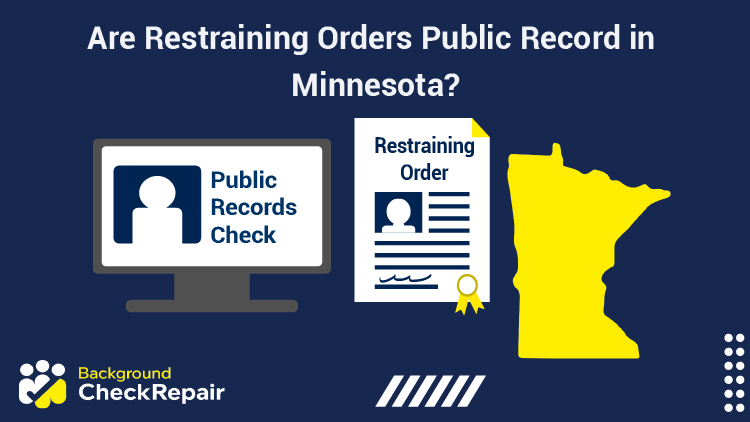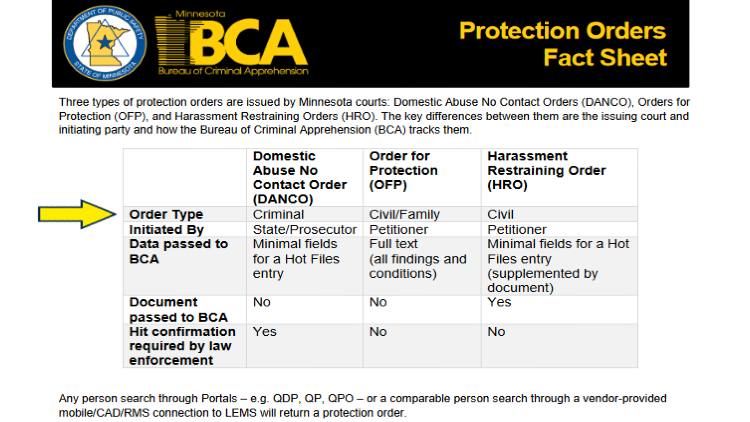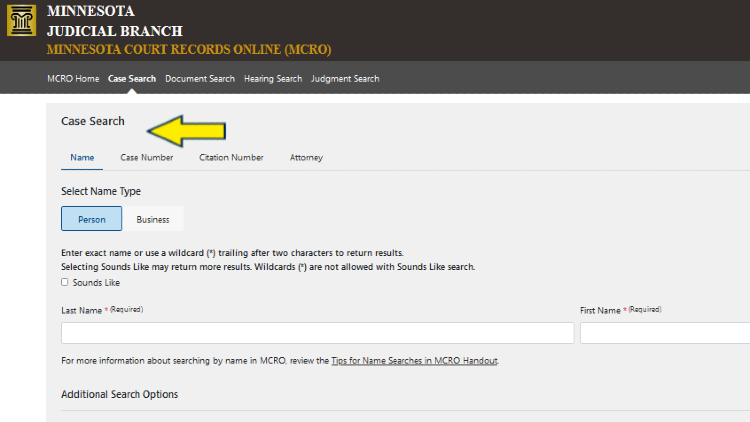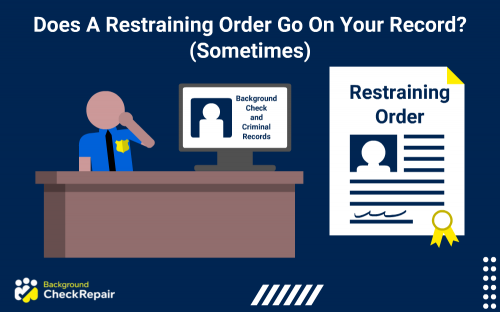
Minnesota is one of many states which favors open access to public records, but are restraining orders public record in Minnesota?
While the answer to this question is technically a yes, there is a very important caveat regarding a MN protection order search.
Understanding the different types of restraining orders in the state of Minnesota and knowing how to conduct a MN protection order search can answer the question, are restraining orders public record in Minnesota?
This complete guide explains everything to know.
Does a Restraining Order Go on Your Record in MN?
A restraining order is a court issue of protection for an individual that feels threatened by another. The court order typically places restrictions on the respondent’s behavior, such as if and how they can communicate with the petitioner or approach the petitioner.
What many people want to know is “Does a restraining order appear on your record in MN?” and “Are restraining orders public record in Minnesota?” To answer these questions, it is necessary to first explore the various types of protection orders available to Minnesota residents.

Minnesota provides three types of protection orders and outlines whether that information is passed to the law enforcement Bureau of Criminal Apprehension.
According to the Minnesota Bureau of Criminal Apprehension (BCA) Protective Orders Fact Sheet, there are three types of restraining orders (sometimes called restraining orders) in MN which are as follows:
- Harassment Restraining Order (HRO)
- Order For Protection (OFP)
- Domestic Abuse No Contact Order (DANCO)
Harassment Restraining Order (HRO)
A harassment restraining order or HRO is the “classic” restraining order that most individuals are probably familiar with. This type of restraining order is civil in nature and is initiated by the petitioner (often the victim or parent of the victim) in the harassment case.
With an HRO, the respondent (suspected individual) need not be a family member or have any significant relationship with the petitioner. In fact, the respondent in an HRO case may be a complete stranger or slight acquaintance, as is often seen in cases that involve stalking or someone in the workplace.3
Order for Protection (OFP)
Orders for Protection, or OFPs, while also civil in nature, differ significantly from HROs because an OFP requires that the respondent have an established relationship with the petitioner or victim.
OFPs are initiated by a petitioner and most often issued in cases of domestic abuse or minor abuse where the respondent is someone who is a blood relation, a current or former spouse or romantic partner, or shares a home or children with the petitioner (See Minnesota Courts Instructions – Asking For An Order For Protection (OFP)). As such, an OFP civil case may be handled in Family Court.
The final type of protective order in Minnesota is the Domestic Abuse No Contact Order (DANCO). Domestic abuse, as defined by Minn. Stat. § 518B.01 (Domestic Abuse Act), is physical harm, fear of harm, terroristic threats, etc., perpetrated by a family or household member (as described in the previous section). Unlike the first two types, DANCO is initiated by a prosecutor as part of a criminal case.
Note: This list does not include a temporary restraining order which is sometimes issued to provide short-term protection for a petitioner leading up to a hearing date.
Returning to the original issue of whether a restraining order goes on record in MN, the short answer is maybe, and here is how. HROs and OFPs are civil court orders which DO NOT show up on a criminal record unless the order has been violated by the respondent, which is a criminal offense.3
In contrast, a DANCO goes on an individual’s criminal record automatically as it is issued in the course of a criminal case.
Does a Harassment Order Go on Your Record in Minnesota?
An HRO is possibly the most common type of restraining order, and many people may wonder does a harassment order appear on your record.
A harassment order does not appear on an individual’s criminal record unless the order has been violated, opening a criminal case. However, the HRO may still be found with a search of civil court records.1
How Long Does a Restraining Order Stay on Your Record in MN?
Anyone who is curious about how long a restraining order remain on your record must consider the following factors carefully:
- Type of restraining order
- Length of the restraining order
- Number of restraining orders
- Whether the order has been violated
As mentioned earlier, civil protection orders only appear on criminal records when they have been violated. While an initial order may be issued for a period of 2 to 3 years, a continued order can be extended up to 50 years if the initial order was violated. In this scenario, the restraining order remains on the criminal record until the duration of the order has expired or unless the judge modifies the order.9
A restraining order may remain on a criminal record for up to 10 years after its expiration.7
Are Restraining Orders Public Record In Minnesota?
Even if a restraining order does not show up on a person’s criminal record, it may still show up in a public record search, leading to the question of are restraining orders public record in Minnesota? The short answer: Yes.

Court records can be accessed in Minnesota using the state’s Judicial Branch website, at a courthouse, or by contacting the department.
Most court records are public in Minnesota, and anyone can access them if they know where and how to look.
Because restraining orders may contain protected information about victims or minor children, there are restrictions on how these records can be accessed. Continue reading for more information on accessing public records, MN.
When Is Restraining Order Public Record in MN?
Knowing that restraining orders are public record in MN is one piece of the puzzle, but it’s also important to know when is restraining order public record.
The most important thing to note here is that a restraining order does not become a matter of public record until the respondent has been served with an order (See Minnesota Courts Limits On Public Access To Case Records).
For How Long Are Restraining Orders Public Record In Minnesota?
According to the Minnesota Court Services Division District Court Record Retention Schedule, all civil case files may be destroyed after 10 years have transpired since the judgment was entered, all orders have expired, or the case was closed.
Where Can I Access Minnesota Public Records? (Public Records, MN)
As an open records state, Minnesota policy supports open access to public records and provides for various routes to search and obtain said records. Although there are some restrictions or limits to data access (See Minnesota Rules of Public Access to Records of the Judicial Branch), the majority of trial court records can be easily accessed online.
The following table provides links to the government resources required to search and access public records in MN via online records databases.
What Is MNCIS Public Access?
The acronym MNCIS stands for the Minnesota Court Information System, an online database containing records for civil and criminal court cases across the state.8
MNCIS public access can be achieved by using Minnesota Public Access (MPA) Remote or by visiting a courthouse and using the MPA Courthouse tool.
Are Restraining Orders Public Record In Minnesota? How Do I Do a Minnesota Restraining Order Search?
Per the Violence Against Women Act of 1994 and subsequent Violence Against Women Act Reauthorization Act of 2021, OFP and HRO orders are prohibited from being displayed on the internet for remote access (See “Fact Sheet: Reauthorization of the Violence Against Women Act (VAWA)“).
Therefore, an individual looking to conduct a Minnesota restraining order search should follow these steps:
- Use the Minnesota Judicial Branch Court Locator to look up a Minnesota courthouse.
- Visit the courthouse during business hours (7:00 am – 5:30 pm M-F).
- Use a computer terminal at the courthouse to access the MPA Courthouse tool (See MPA Courthouse FAQs).
- Use the Help option in the application or ask a courthouse official for assistance with any questions.
- Search unofficial court records for free!
For official copies of court records, an individual must contact or visit the district court where the case was heard.
How To Do a State of Minnesota Court Records Search (MN Court Case Lookup)
Family court records are often a bit more difficult to access than other court records due to the sensitive nature of the content, but in most other cases, a state of Minnesota court records search can be conducted easily online (See Minnesota Judicial Branch “How to Search Court Records Online”).
To do an MN court case lookup, follow these steps:
- Access Minnesota Court Records Online (MCRO) by clicking the brown “Access MCRO” button in the upper right of the page.
- Select “Case Search” at the top of the page.
- Choose search by “Name,” “Case Number,” “Citation Number,” or “Attorney.”
- Enter search information and click “Find.”5.
- Identify the case of interest and click “View Case Details.”
Can I Do A Minnesota Court Records Search By Name?
It is possible to do a Minnesota court records search by name using the Minnesota Court Records Online (MCRO) search tool. The Minnesota Judicial Branch has a document guide for conducting name searches (See “Handout – Tips for Name Searches”). A few of the primary points in the document for doing name searches in MCRO are:

The case search feature on the Judicial site can find court documents based on case number, name, citation number or legal representative.
- Name searches should be exact
- An asterisk may be used as a wildcard to return more results
- It is best to search a name multiple ways (with a middle name, with a middle initial)
- The “Sounds Like” function can be used to pull names that sound similar.
Does a Restraining Order Show Up on a Minnesota Background Check? (Restraining Order Background Check Minnesota)
What shows up on a Minnesota background check depends entirely upon the type of background check conducted, as various checks may reveal different information. It is possible for a restraining order to show up on a Minnesota background check, particularly if the check is conducted as part of a criminal investigation or for government employment.

Searching criminal history in Minnesota is simple and can be done with just a name and date of birth.
Most restraining orders are civil rather than criminal in nature. Thus, to reveal a past or current restraining order, background check must search civil court records in addition to criminal records. Although most employment background checks will not go this extra length, some may, particularly if the nature of the job position warrants a more in-depth investigation.1
Note that the Fair Credit Reporting Act (FCRA) does limit reporting of adverse information in civil cases to the most recent 7 years, so restraining orders older than 7 years should not show up in most background checks.
Another way for a restraining order to show up on a criminal background check is if the respondent violated the civil order. When this happens and a police report is made, the restraining order becomes attached to the respondent’s criminal record.
Criminal background checks in the state of Minnesota can be conducted through the Minnesota Bureau of Criminal Apprehension (BCA) using their Criminal History System (CHS).6
The state of Minnesota has various types of restraining orders which may be issued when necessary.
While most protective orders are civil in nature, Minnesota has one exception which is a criminal protective order. Understanding the types of restraining orders in MN is crucial to knowing when are restraining orders public record in Minnesota and how to do an MN protection order search.
Frequently Asked Questions About Are Restraining Orders Public Record in Minnesota









